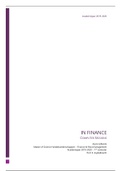Summary
Samenvatting Onderzoeksmethoden in Finance - Computer Sessions - notities 2019
- Course
- Institution
- Book
Notities en screenshots van Gretl van Computer Sessions voor het vak Onderzoeksmethoden in Finance, in de master Handelswetenschappen - Finance en Riskmanagement. *Beoordeling(sterren)/feedback wordt geapprecieerd.*
[Show more]




